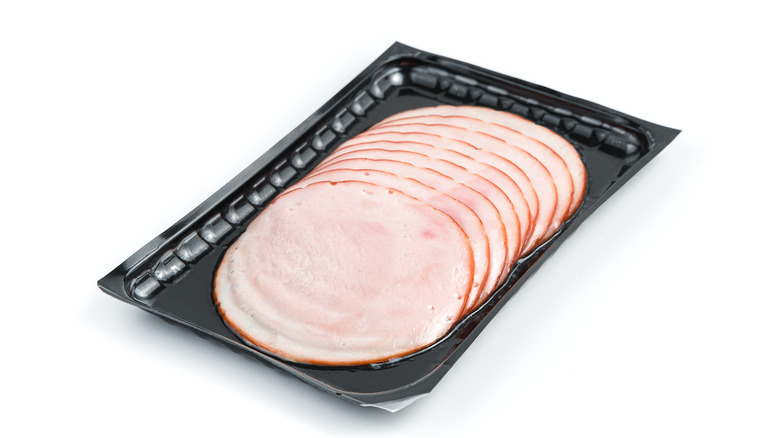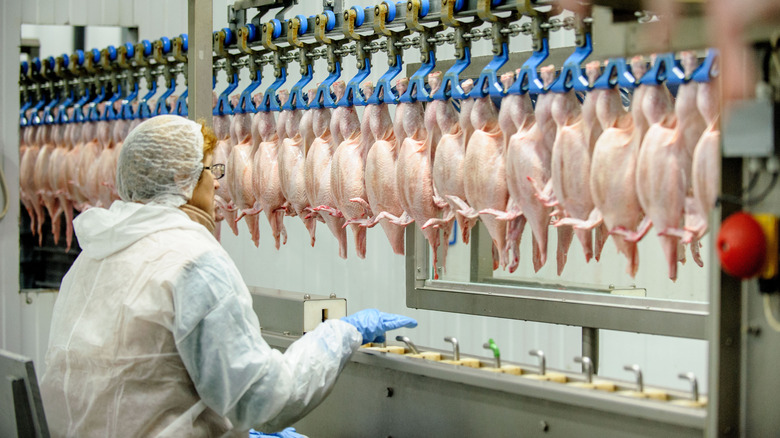You may have looked at turkey ham in the deli section of your grocery store and asked yourself, “What the heck is that?” It doesn’t make much sense at first, like products labeled “chicken beef” or “salmon pork.” Plus, ham has to be made with pig thigh meat by law. But rest assured, turkey ham is made from turkey. Theres no pork in it. Advertisement.
Its a similar type of confusion as the kind associated with almond milk and other non-dairy milk alternatives. An article from the New York Times in 1976 says that turkey ham got into legal trouble with pork producers, just like non-dairy milks do with dairy companies these days. Obviously, turkey ham was able to keep its name, or we wouldnt know it as such today. Because of those legal problems, turkey ham products now have to have a subheading that says “cured turkey thigh meat” to make it clear what it is.
Strolling down the deli aisle, you may have spotted something called “turkey ham” nestled alongside the regular ham, roast beef, and other lunchmeat classics At first glance, it seems like a paradox – ham comes from pork, not poultry! So what gives with this mystery meat? Let’s unravel the truth behind turkey ham and see what makes this processed product tick
The Origin Story
Turkey ham was invented in 1975 by Jennie-O, the Minnesota-based turkey company. They had excess turkey thighs and were looking for an innovative way to use them.
By curing and shaping turkey thigh meat to resemble ham, Jennie-O created a brand new lunchmeat After its debut, turkey ham was bringing in 10 times more profit than plain turkey thighs!
Other brands soon followed Jennie-O’s lead. By 1980 turkey ham was sparking legal troubles with pork producers over the name. But the moniker stuck, with the modifier “cured turkey thigh meat” added to packaging.
How Turkey Ham is Made
Turkey ham is a cured, shaped, and smoked meat made from the thighs of turkeys. Here’s an overview of the production process:
- Turkey thighs are deboned by machine
- A curing brine is injected deep into the meat. This brine contains water, salt, sugars, sodium nitrite, phosphates, erythorbate, and other curing agents.
- Thigh meat soaks for hours to cure. The brine preserves, flavors, and colors the meat.
- Cured thighs are smoked and cooked. Smoking adds flavor.
- Meat is shaped into a log and pressed into a ham mold.
- Slices are packaged as deli meat or sold as a whole smoked ham.
Binders are often added to improve moisture and texture. Turkey ham typically has 5% fat content, with some brands offering low-fat or fat-free versions.
How Turkey Ham Differs from Regular Ham
While the curing process is similar, there are some distinct differences:
-
Ingredients – Ham is cured pork, while turkey ham is 100% poultry.
-
Color – Turkey ham is darker than traditional ham.
-
Fat Content – Ham can be quite fatty. Turkey ham is lower in fat.
-
Price – Turkey ham is generally cheaper than true ham.
-
Sodium – Both meats are high in sodium, but turkey ham often has a bit less.
-
Flavor – Turkey ham is milder in flavor compared to the richer, smokier taste of ham.
While not exactly the same, turkey ham was designed to mimic the texture, appearance, and saltiness of ham at a lower cost.
The Taste and Texture
When you bite into a slice of turkey ham, expect a firm, dense texture with a subtle saltiness. There’s a faint smoky flavor from the smoking process. The breast-like meat has a mildly savory taste and lean mouthfeel.
Some herbs and spices like garlic or jalapeño may be added by certain brands, but overall turkey ham is pretty simple. It lacks the intense porkiness and smokiness of true ham. The flavor profile lands somewhere between ham and turkey breast deli meat.
Nutritional Profile
A 2 ounce serving of turkey ham (about 2 slices) contains:
- Calories: 60-80
- Protein: 7-10g
- Fat: 2-3.5g
- Sodium: 300-500mg
Turkey ham can be a good source of lean protein. But it does come with ample sodium like most cured meats. Moderation is key, as processed meats may also increase health risks if consumed in excess.
Uses for Turkey Ham
Turkey ham makes an easy sandwich addition or rollup filling. Stack it on bread or wraps with cheese, lettuce, and condiments. Or use it to top salads, pizzas, omelets, and baked potatoes.
Because the flavor profile is mild, turkey ham works in many recipes. Substitute it for regular ham in classics like ham and bean soup or ham and cheese sliders. Get creative with casseroles, egg bakes, pasta salads, and more!
Where to Buy Turkey Ham
Check the packaged meat section or deli counter at your local supermarket. Popular brands like Jennie-O, Oscar Mayer, and Butterball are widely available. You can also find specialty turkey ham at butcher shops or order online.
Turkey ham comes as presliced deli meat or as a whole smoked log. Opt for thick cut slices for sandwiches. A boneless, spiral cut ham makes an easy holiday main course.
The Takeaway
While turkey ham may seem like a head-scratcher, this processed poultry product has carved out a niche in the deli meat world. With its mild flavor, lean protein, and cured meat texture, turkey ham offers a different twist on the classic ham experience. Add some to your next sandwich or charcuterie board and savor this retro-inspired lunchmeat.

What does turkey ham taste like?

Turkey ham tastes, well, like ham. It has a similar salty brininess to it that we so often associate with deli meat ham. Theres also a touch of sweetness, but it isnt honey-sweet by any means. The texture is chewy without being rubbery. If you know how most processed deli meats feel, turkey ham texture is similar to the other styles. Advertisement.
Smoked paprika is often spread on the outside of turkey ham to make it taste even better. It’s not spicy, but the paprika adds a good amount of spice to a flavor profile that is otherwise pretty mild. Of course, deli meat usually tastes mostly salty, and turkey ham is the same way, even with the smoked paprika added. The turkey ham will usually go well with other foods because it won’t overpower them. However, you probably wouldn’t want to add it to a sweet dish.
How is turkey ham made?

Because turkey ham is meant to taste and feel like regular ham, it is cooked in the same way. If you look at the big picture, boneless ham is either cured, smoked, or both. There are many other ways to prepare ham. Advertisement.
For turkey ham, the turkey thigh meat is first deboned. That’s when a mix of salt, sugar, sodium diacetate, sodium erythorbate, sodium phosphate, sodium nitrite, potassium lactate, and water are injected into the meat to cure it. Curing meat is a process of food preservation that dates back to 3,000 B. C. There are two types of curing: wet and dry. For dry curing, you rub a mixture of salt and spices on the outside of the meat. For wet curing, you add water to make a brine. Turkey ham uses a wet method, as does traditional ham. The turkey is put in the brine and left to rest for a few hours. The cure is finished when the meat is cooked.
Turkey ham – A delicious pork ham alternative
FAQ
What kind of meat is a turkey ham?
What’s the difference between ham and turkey ham?
Does turkey ham still exist?
Why does turkey ham exist?
